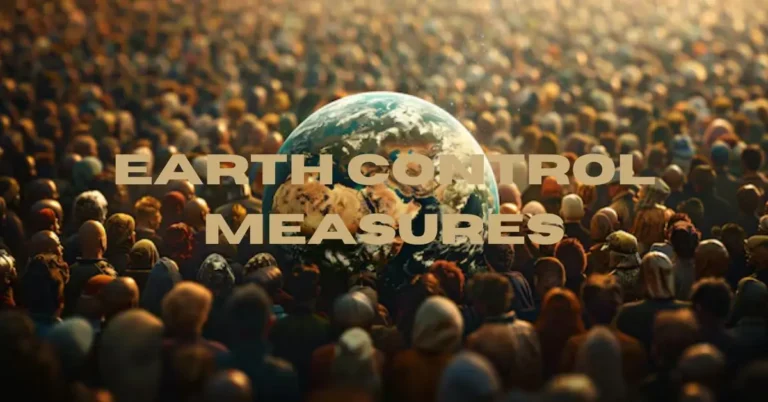Earth control measures are vital strategies employed to manage and protect our land from the damaging effects of erosion, flooding, and land degradation. With increasing urbanization and changing weather patterns due to climate change, the need for sustainable and long-term earth control solutions has never been more urgent. These measures not only protect the environment but also support agriculture, infrastructure development, and the preservation of ecosystems.
In this guide, we will delve deep into the various types of earth control measures, their importance, and how they contribute to creating a sustainable future.
Introduction to Earth Control Measures
As the planet faces the increasing impacts of climate change, effective earth control measures have become a priority for urban planners, environmentalists, and agricultural sectors. These strategies focus on minimizing soil erosion, reducing sediment transport, preventing floods, and enhancing land productivity. Employing earth control measures ensures that the land remains fertile, useful, and sustainable for generations to come.
Implementing the right earth control practices is essential for areas prone to heavy rainfall, wind erosion, or unstable soil conditions. The benefits of these measures go beyond environmental conservation, as they also prevent costly damage to infrastructure and help maintain healthy ecosystems.
What Are Earth Control Measures?
Earth control measures refer to practices and techniques used to mitigate the negative effects of soil erosion, water runoff, and sediment deposition. These methods are designed to stabilize land, improve soil health, and ensure long-term sustainability. Earth control measures can be implemented in various environments, from agricultural fields to urban landscapes, and are essential for combating both natural and man-made degradation.
The purpose of earth control measures is to prevent the displacement of soil caused by wind, water, or human activities. They ensure that the earth’s surface remains intact, preventing landslides, floods, and desertification.
The Importance of Earth Control Measures
Earth control measures are critical for a variety of reasons. First and foremost, they help to preserve soil integrity, which is essential for plant growth and food production. Without healthy soil, agriculture would become unsustainable, leading to food shortages and economic instability. Additionally, these measures help to control water flow, reducing the risk of floods and protecting infrastructure from damage.
Another crucial reason for implementing earth control strategies is to combat climate change. Healthy soils act as carbon sinks, absorbing CO2 from the atmosphere and mitigating the effects of greenhouse gases. By maintaining soil health and preventing erosion, we can reduce the impact of climate change on the environment.
Types of Earth Control Measures
There are several different earth control measures that can be employed, depending on the specific needs of an area. Below are some of the most common types of earth control methods:
Erosion Control Methods
Erosion control methods are designed to prevent the loss of soil due to water or wind. Some of the most effective erosion control techniques include:
- Contour Plowing: This involves plowing along the contours of a slope to reduce water runoff and soil erosion.
- Terracing: Terraces are constructed on slopes to slow down water flow and reduce soil loss.
- Vegetative Cover: Planting grass, trees, or shrubs helps to hold soil in place and protect it from erosion.
Sediment Control Techniques
Sediment control focuses on trapping soil particles before they enter waterways. Common sediment control measures include:
- Silt Fences: These are temporary barriers made of fabric that trap sediment while allowing water to pass through.
- Sediment Basins: These are constructed to capture sediment-laden runoff, preventing it from reaching rivers and streams.
Water Control Measures
Water control measures help to manage and direct the flow of water, preventing flooding and soil erosion. Examples include:
- Check Dams: Small dams built across water channels to slow down water flow and reduce erosion.
- Swales: Shallow ditches that are designed to capture and redirect water runoff, preventing erosion and flooding.
Soil Conservation Techniques
Soil conservation methods aim to maintain soil health and prevent degradation. These techniques are often employed in agricultural settings and include:
- Crop Rotation: This involves alternating crops to improve soil health and reduce the need for chemical fertilizers.
- Mulching: Applying a layer of organic material to the soil surface helps to retain moisture and prevent erosion.
Urban Earth Control Measures
In urban areas, earth control measures are essential for managing stormwater runoff and preventing soil erosion in construction sites. Techniques include:
- Green Roofs: Vegetation planted on rooftops absorbs rainwater, reducing runoff and providing insulation.
- Permeable Pavements: These allow water to pass through, reducing surface runoff and preventing erosion.
The Role of Vegetation in Earth Control
Vegetation plays a crucial role in many earth control measures. Plants help to stabilize the soil, reduce erosion, and improve water infiltration. By covering the ground, vegetation prevents rain from washing soil away and helps to absorb water, reducing runoff.
In agricultural areas, cover crops are often planted to protect the soil during the off-season. In urban settings, green spaces and trees can help to absorb rainwater and reduce the risk of flooding. The benefits of vegetation extend beyond earth control, as they also contribute to cleaner air, improved biodiversity, and enhanced quality of life.
Sustainable Earth Control Practices
Sustainability is at the heart of effective earth control measures. Sustainable practices aim to protect the environment while meeting human needs, ensuring that resources are available for future generations. Some sustainable earth control practices include:
- Agroforestry: This involves integrating trees into agricultural systems to provide shade, prevent erosion, and improve soil health.
- Rainwater Harvesting: Capturing and storing rainwater reduces the need for artificial irrigation and prevents excessive runoff.
- Reforestation: Planting trees in deforested areas helps to stabilize the soil and restore ecosystems.
The Impact of Climate Change on Earth Control
Climate change has a significant impact on the effectiveness of earth control measures. As weather patterns become more unpredictable, with more frequent and intense storms, traditional earth control methods may no longer be sufficient. To address these challenges, new strategies and technologies are being developed to cope with changing conditions.
For example, regions experiencing more frequent flooding may need to implement larger-scale water control measures, such as flood barriers or improved drainage systems. In areas prone to drought, soil conservation practices that retain moisture, such as mulching or drip irrigation, become essential.
Technological Innovations in Earth Control
Technology is playing an increasingly important role in improving earth control measures. Innovations such as remote sensing, drones, and geographic information systems (GIS) are being used to monitor erosion, track water runoff, and plan sustainable land use.
Additionally, new materials and construction methods are being developed to create more effective erosion control barriers and improve water management systems. These technological advancements allow for more precise and efficient earth control practices, ensuring better protection for the environment and infrastructure.
The Future of Earth Control Measures
As we move into the future, earth control measures will continue to evolve in response to environmental challenges. Climate change, urbanization, and population growth will require more innovative and sustainable approaches to managing land and water resources. Collaboration between governments, businesses, and communities will be essential in implementing effective earth control strategies on a global scale.
Challenges and Solutions in Earth Control
Despite the importance of earth control measures, there are several challenges to their implementation. In many cases, lack of awareness, funding, or political will can hinder the adoption of effective earth control practices. Additionally, some areas may lack the technical expertise or resources needed to implement these measures successfully.
However, there are solutions to these challenges. Education and outreach programs can raise awareness about the benefits of earth control measures, while government incentives and funding can help to support their implementation. Partnerships between public and private sectors can also provide the resources and expertise needed to develop innovative earth control solutions.
Earth Control Measures and Public Policy
Public policy plays a crucial role in promoting earth control measures. Governments at all levels can create regulations and incentives to encourage the adoption of sustainable practices. For example, laws that require erosion control plans for construction projects or provide tax incentives for sustainable farming practices can help to ensure that earth control measures are implemented effectively.
Earth Control in Agricultural Practices
Agriculture is one of the primary sectors affected by soil erosion and land degradation, making earth control measures essential for maintaining productivity. Farmers use various methods, such as contour plowing, terracing, and agroforestry, to protect the soil and ensure sustainable crop yields. Sustainable farming practices, like crop rotation and organic farming, also contribute to better soil health and reduced erosion.
Earth Control for Infrastructure Protection
Erosion and soil degradation can have severe consequences for infrastructure, leading to costly repairs and increased risk of natural disasters. Earth control measures are essential for protecting roads, bridges, and buildings from damage caused by unstable land. By implementing proper drainage systems, retaining walls, and erosion barriers, we can prevent land degradation and ensure the longevity of infrastructure projects.
Conclusion
Earth control measures are essential for protecting our environment, ensuring sustainable land use, and preventing the damaging effects of soil erosion, flooding, and land degradation. As climate change continues to alter the natural landscape, the need for innovative, sustainable, and effective earth control strategies will only grow. By implementing these practices, we can preserve the health of our land, safeguard ecosystems, and ensure a sustainable future for generations to come.
FAQs
What are the main types of earth control measures?
Earth control measures include erosion control, sediment control, water control, and soil conservation methods, each aimed at stabilizing land and preventing degradation.
How do earth control measures benefit agriculture?
They help maintain soil health, prevent erosion, and ensure sustainable crop production, which is vital for long-term agricultural success.
What role does vegetation play in earth control?
Vegetation stabilizes soil, reduces erosion, and improves water infiltration, making it a key component of many earth control practices.
How does climate change affect earth control measures?
Climate change can increase the frequency of extreme weather events, requiring more robust and adaptive earth control strategies to cope with floods, droughts, and erosion.
Are there sustainable earth control practices?
Yes, practices such as agroforestry, rainwater harvesting, and reforestation are sustainable earth control methods that protect the environment and promote long-term land health.
How can technology improve earth control measures?
Technological innovations like GIS, drones, and advanced materials are enhancing the precision and effectiveness of earth control strategies, allowing for better environmental protection.



